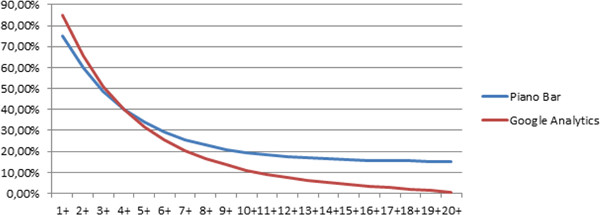Aligning Your Marketing and Sales Teams Around Marketing Attribution
Whether you work in a mature company or a start-up, it's essential to ensure that your marketing and sales teams are aligned around a single business vision to achieve your customer acquisition and retention goals. By improving the working relationship between your two departments, you can significantly improve your chances of optimizing your turnover and sustaining your business. Of course, to achieve this, you need to commit time, resources and effort. In this article, we'll look at the importance of strengthening the cohesion of both departments internally and how following a concerted marketing attribution strategy can create valuable business synergy.
Why align marketing and sales teams?
In the past, marketing consisted of spending huge amounts of money on channels that could hardly be measured, such as print ads in the press, booths at conventions, etc. Then, as time went by, marketing expenses were streamlined to promote campaign return on investment. The rise of digital technology has gradually accelerated the development of lead generation in companies. This approach involves attracting a large number of visitors and prospects, and then converting them into customers, using an inbound marketing strategy (newsletters, emailing, blog articles, infographics, webinars, podcasts, case studies, etc.) or an outbound strategy (advertising, canvassing, sales prospecting).
Avoiding potential internal friction
In a digital environment, it has become much easier to test, iterate and optimize your marketing strategy and, thanks to the mining of performance data, to define a production schedule. But in modern customer acquisition, it is essential for marketing and sales teams to communicate and coordinate, especially when they share the same conversion funnel. But let's be honest, in B2B, we all know that the relationship between the two departments is not always smooth. The sales team can often criticize poor lead quality or a lack of contact maturity, while the marketing team questions the lack of feedback from the field and sales insights, or a lack of CRM tool updates. However, both teams are working towards the same goal: to increase and sustain the company's sales. So why can they sometimes clash?
Strengthen cooperation around common goals
Sometimes both teams focus on different key performance indicators (KPIs) to define their acquisition strategy. Marketers focus on KPIs such as traffic sources, number of visits or downloads, click-through or open rates. Sales teams, on the other hand, tend to base their analyses on key customer behavior indicators (KBIs) such as incremental sales, customer lifetime value, and revenue opportunities. The former seek to deliver large volumes of leads in the medium and long term; the latter want to convert them with the highest possible profitability, often in the short term. This lack of harmony can lead to opposition, disagreement and even potential conflict between the two groups. And the problem can be even worse if the sales do not materialize.
So, to optimize team cooperation, there's no magic formula: you need to bring them together around a common strategic vision and similar objectives. The trend to align sales and marketing departments is called Smarketing (a contraction of Sales and Marketing). Here are the principles of this model.
Smarketing for marketing attribution
Smarketing involves implementing tools and practices to break down the barriers between the marketing and sales departments, improve cooperation between the two sides and thereby optimize the company's results.
This organization is all the more important at a time when companies are developing Account-Based Marketing (ABM) approaches. Indeed, these approaches are based on both marketing and sales expertise, as they require the identification of key account decision-makers, the identification of their expectations, their categorization and the activation of personalized and relevant content in order to ultimately convert them.
To implement Smarketing, you have to follow several essential steps:
- Agree on the qualification of a lead, by defining a Marketing Qualified Lead (MQL) and a Sales Qualified Lead (SQL) in advance. By formalizing the essential qualification criteria (identity, business information, purchase potential, etc.), you can then build buyer personas and establish a scoring system (lead scoring). These tools allow you to measure a prospect's interest in your products and services, and their position in the sales cycle.
- Select common SMART objectives. An improvement in the conversion rate, a growth in turnover, an increase in the average basket, a target number of SQL to reach (which mechanically allows you to define an average volume of MQL), an increase in the return on investment... Here are some examples of general objectives that can unite your teams. In companies that operate in SaaS mode on a subscription basis, there is a tendency to focus on Monthly Recurring Revenue (MRR), which gives an overall trend on the acquisition of new customers, the retention of current customers and the success of up-selling approaches.
- Design a Service-Level Agreement (SLA). This contract details all the commitments made by the two services in terms of missions and results. It summarizes the objectives, the buyer personas, the obligations, the roles of each party, the processes for managing the prospect in the sales cycle, the volumes of leads to be generated, etc.
- Produce collaborative content. Sales teams can bring their expertise and industry knowledge to marketers to write more targeted, higher-value content that will engage customers.
- Share recurring reports and analyze data closely. Through regular meetings, you can share the various data collected to evaluate the results observed in relation to the objectives, to judge the relevance of the leads, to refine the targeting strategies or to reorient the efforts in the production of content.
Involve sales teams in the development of the marketing attribution strategy
Marketing attribution allows you to determine all the touchpoints (email campaign, search, display, affiliation...) through which a consumer transits and which influence them to make a purchase from your brand. Armed with all this information, marketers can more easily identify the most effective channels in terms of conversion and thus continuously optimize the makeup of their marketing mix.
Marketing attribution can also support the coordination of your marketing and sales teams from a CRM tool because you have data from both departments at all stages of the sales funnel, from lead qualification to conversion.
To optimize your attribution processes, it is essential to clearly identify the roles of each person and to determine the precise moment in the buying process when they are able to intervene and add value.
Next, tag the various interactions so you can analyze them:
- Tagging marketing campaigns
- Tagging online conversions
- Tagging sales interactions with custom events:
- Generate hits from customer calls
- Generate hits from Salesforce contacts
- Generate hits from customer interactions at conferences
Good to know: With Piano Analytics, you can measure all your data and fully customize the tool to your needs.
With highly accurate data, an attribution model adapted to your organization and the application of a method like Smarketing, you can effectively measure, understand and significantly improve the performance of your digital business.
And don't forget that marketers also need to know the business mechanics throughout the customer lifecycle. This way, they can better identify their opportunities for action and, with a complete view of the funnel and the stages of lead nurturing, decide on the timing of an email or a follow-up period, or prioritize the creation of a sales support tool (case study, customer testimonial, etc.) to finish convincing the prospect.




